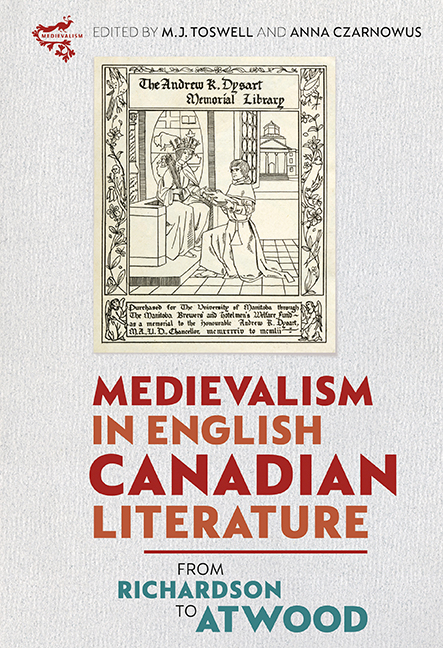Book contents
- Frontmatter
- Contents
- Introduction: English Canadian Medievalism
- 1 “Men of the North”: Archibald Lampman's Use of Incidents in the Lives of Medieval Monarchs and Aristocrats
- 2 “Going Back to the Middle Ages”: Tracing Medievalism in Julia Beckwith Hart's St. Ursula's Convent and John Richardson's Wacousta
- 3 John Richardson's Wacousta and the Transfer of Medievalist Romance
- 4 A Canadian Caliban in King Arthur's Court: Materialist Medievalism and Northern Gothic in William Wilfred Campbell's Mordred
- 5 Orientalist Medievalism in Early Canadian Periodicals
- 6 The Collegiate Gothic: Legitimacy and Inheritance in Robertson Davies's The Rebel Angels
- 7 Earle Birney as Public Poet: a Canadian Chaucer?
- 8 “That's what you get for being food”: Margaret Atwood's Symbolic Cannibalism 129
- 9 Lost in Allegory: Grief and Chivalry in Kit Pearson's A Perfect, Gentle Knight
- 10 Remembering the Romance: Medievalist Romance in Fantasy Fiction by Guy Gavriel Kay and Charles de Lint
- 11 Medievalisms and Romance Traditions in Guy Gavriel Kay's Ysabel
- 12 The Medieval Methods of Patrick DeWitt: Undermajordomo Minor
- Index
- Miscellaneous Endmatter
8 - “That's what you get for being food”: Margaret Atwood's Symbolic Cannibalism 129
Published online by Cambridge University Press: 25 March 2020
- Frontmatter
- Contents
- Introduction: English Canadian Medievalism
- 1 “Men of the North”: Archibald Lampman's Use of Incidents in the Lives of Medieval Monarchs and Aristocrats
- 2 “Going Back to the Middle Ages”: Tracing Medievalism in Julia Beckwith Hart's St. Ursula's Convent and John Richardson's Wacousta
- 3 John Richardson's Wacousta and the Transfer of Medievalist Romance
- 4 A Canadian Caliban in King Arthur's Court: Materialist Medievalism and Northern Gothic in William Wilfred Campbell's Mordred
- 5 Orientalist Medievalism in Early Canadian Periodicals
- 6 The Collegiate Gothic: Legitimacy and Inheritance in Robertson Davies's The Rebel Angels
- 7 Earle Birney as Public Poet: a Canadian Chaucer?
- 8 “That's what you get for being food”: Margaret Atwood's Symbolic Cannibalism 129
- 9 Lost in Allegory: Grief and Chivalry in Kit Pearson's A Perfect, Gentle Knight
- 10 Remembering the Romance: Medievalist Romance in Fantasy Fiction by Guy Gavriel Kay and Charles de Lint
- 11 Medievalisms and Romance Traditions in Guy Gavriel Kay's Ysabel
- 12 The Medieval Methods of Patrick DeWitt: Undermajordomo Minor
- Index
- Miscellaneous Endmatter
Summary
MARGARET ATWOOD is not typically referred to as a medievalist writer, and her novels, perhaps with the exception of The Handmaid's Tale, are not often scrutinized for echoes of the medieval past. Instead, the novelist’s engagement with the romance tradition has been connected no further back than the Gothic, which is usually constructed as the source for her neo-medievalist threads. And yet in the works that will form the core of my analysis, The Edible Woman and The Robber Bride, Atwood takes us directly – rather than through the medium of Gothic fantasies – to the long-ago and far-off medieval and early modern past. In fact, what seems to inform much of Atwood's oeuvre is her knowledge of the source material and her genuine interest in the auctoritates to whom Chaucer and other medieval poets paid their respects. This connection to medieval authority seems to be a primary manifestation of her medievalism.
In the Introduction to The Cambridge Companion to Medievalism, Louise D’Arcens makes a distinction between “the medievalism of the ‘found’ Middle Ages and the medievalism of the ‘made’ Middle Ages.” The former sees the Middle Ages as a historical category and is based on examining objects of medieval material culture, whereas the latter approaches the medieval past in a more creative manner and involves an imaginative reconstruction of the medieval world. Margaret Atwood does not identify with the “made” medievalism of the nineteenth century. She does not see the past as a Golden Age, an idyllic childhood of modernity, and in her works makes a point against embellishing the medieval past, that is, adding colours unknown to the period. Neither does she situate her works along the line of continuity, starting with the Middle Ages, moving through the Romantic and Victorian British medievalisms, and ending with the Canadian expression of the medievalizing spirit. Instead, for this Canadian writer the medieval period forms a reservoir of motifs, images, and ideas representative of a common European past in the same way that Chaucer saw himself as a European poet, participating in European cultural heritage, represented by poets such as Dante and Petrarch, among others, as well as their predecessors Homer, Virgil, Horace, and Ovid.
- Type
- Chapter
- Information
- Medievalism in English Canadian LiteratureFrom Richardson to Atwood, pp. 129 - 142Publisher: Boydell & BrewerPrint publication year: 2020



